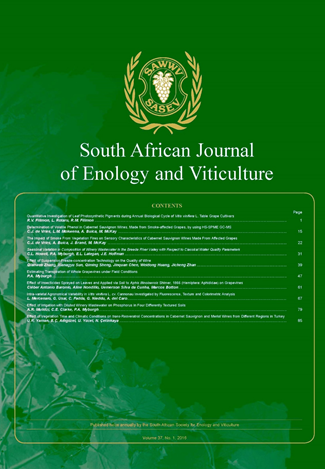Effect of Suspension Freeze-concentration Technology on the Quality of Wine
DOI:
https://doi.org/10.21548/37-1-757Abstract
One of the factors that inhibits the development of the Chinese wine industry is that the sugar content ofthe grape feedstock is insufficient. In order to produce wine with better qualities using these materials,
concentrating the grape juice could be a good alternative to adding sugars. In this study, suspension freezeconcentration
technology was applied to concentrating grape juice with a low sugar content. The freezeconcentrated
grape juice was made into red and white wines separately. In the control group, red and
white wines were made from chaptalized (sugar-enriched) grape juice. The physical and chemical indexes,
sensory evaluation results and polyphenolic content of the wine were analysed to evaluate the practicality
of applying the freeze-concentration technology in the wine industry. The results show that, after removing
ice every 30 min for approximately 14 h with a -18°C coolant, grape juice with an initial sugar content of
14°Brix reached 23°Brix. Both the red wines and white wines made from freeze-concentrated grape juice
were of a higher quality than the wines made from chaptalised grape juice. Moreover, the phenolic content
was concentrated, which may provide health benefits. Thus, suspension freeze-concentration technology is
a promising alternative to traditional chaptalisation technology.
Downloads
Downloads
Published
Issue
Section
License
A copyright form will be e-mailed to the corresponding author when the manuscript has been accepted for publication.
In principle, the Author agrees to the following when he/she signes the copyright agreement:
I hereby assign to the SOUTH AFRICAN SOCIETY FOR ENOLOGY AND VITICULTURE (SASEV) the copyright of the text, tables, figures, supplementary material, illustrations and other information (the Material) submitted with the manuscript to be published in SOUTH AFRICAN JOURNAL OF ENOLOGY AND VITICULTURE (SAJEV) (the "Article"). The copyright becomes effective from the date the Article has been accepted for publication in SAJEV.
This is an open access journal, and the authors and journal should be properly acknowledged, when works are cited.
Author's may use the publishers version for teaching purposes, in books, theses, dissertations, conferences and conference papers.
A copy of the authors' publishers version may also be hosted on the following websites:
- Non-commercial personal webpage or blog.
- Institutional webpage.
- Authors Institutional Repository.
The following notice should accompany such a posting on the website: This is an electronic version of an article published in SAJEV, Volume XXX, number XXX, pages XXX - XXX, DOI. Authors should also supply a hyperlink to the original paper or indicate where the original paper (www.journals.ac.za/index.php/sajev/) may be found.
Authors publishers version, affiliated with the Stellenbosch University will be automatically deposited in the University's Institutional Repository SUNScholar.
Articles as a whole, may not be re-published with another journal.
The following license applies:
Attribution CC BY-NC-ND 4.0

